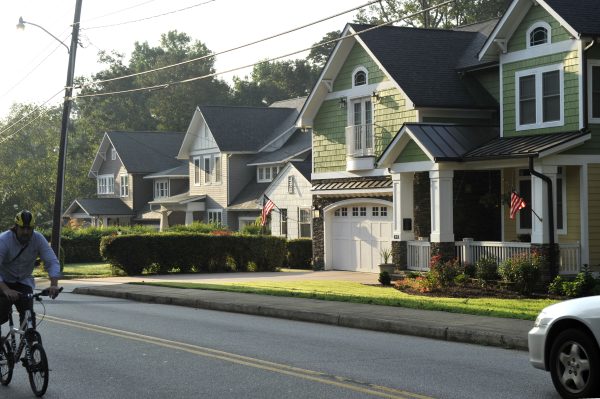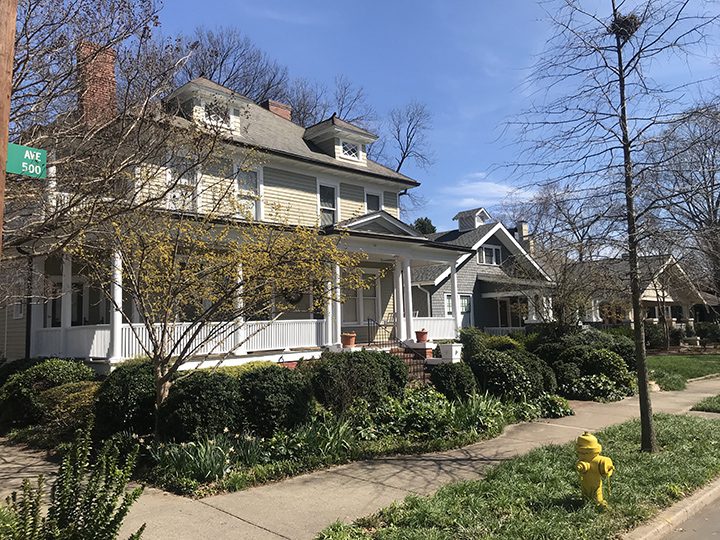Opinion: Let’s steer clear of the “D-word” when it comes to housing

“Did you know? Charlotte’s going to ban single-family zoning!”
I overheard this at a local coffee shop the other day. I should have walked over and told the speaker that’s not true, but I was too shy.
So let me say here, very clearly: It is not true that Charlotte planners intend to ban single-family homebuilding. But some important changes are coming.
This can get a bit complicated, so let me briefly explain.
Readers of this blog will probably know that Charlotte is in the process of creating two new documents that will guide the city’s future up to the year 2040: a Comprehensive Plan and a Unified Development Ordinance, or UDO. The “Comp Plan” establishes the city’s detailed vision of how it wants to develop, establishing goals and policies to improve the city’s physical, social, economic, and environmental conditions. As a companion to the Plan, the UDO provides the zoning rules and local laws that control developments to align with those goals. These two documents need to work in harmony with each other.
It’s also common knowledge that Charlotte has a major housing crisis on its hands; there are simply not enough homes available for workers and their families at prices affordable to large segments of our population. Moreover, there are considerable systemic difficulties in the ways that housing is produced and financed in the U.S. that make this problem very difficult to solve. That’s where bold, new thinking in the Comp Plan and the UDO can make a big difference.
[Read more: Can we build our way out of the housing affordability crisis?]
The key here lies in the catchy phrase “missing middle housing.” This means the different types of affordable housing that used to be commonplace in American cities before the 1950s when we changed all the zoning rules to mandate single-family suburbia. Before World War II, many American communities comprised a heterogeneous patchwork of different types of housing, all blended together over time.
But post-war zoning effectively made America’s historic neighborhoods illegal. No longer could you live above the store. No longer could you build a duplex, triplex, or quadraplex amidst single-family houses. Now, most new housing was a homogenous spread of nothing but single-family bungalows. Apartments were all lumped together and quarantined off in a different part of the city. But stroll through any historic district here in Charlotte and what do you see? Exactly that old-fashioned mix of duplexes and quadraplexes nestled amongst single-family dwellings.
Take a look the next time you’re in Dilworth — it’s hard to miss the two-, three- and four-unit houses amongst the bungalows once you start looking. But today because of their rarity today these modest homes — the “missing middle” range of housing choices — are now too expensive for many people. We need to build more of them. A lot more.
Some more eye-popping numbers on our housing market from @CRRAtweets today:
– Sales up 3.6% y-o-y in Feb.
– Prices up 9% avg ($304,569) and 11.9% median ($262,640)
– Inventory down 31.3% from 1 year ago. That’s…a LOT. Only 1.5 mos. supply in the 16-county region. pic.twitter.com/odJq0zv9Y1— Ely Portillo (@ESPortillo) March 11, 2020
In order to achieve this goal, there is one essential change we must make in our thinking and our vocabulary. As we work through Charlotte’s Comp Plan and UDO, we must do our best to avoid conversations about increasing “density.” If I was running Charlotte’s Comp Plan process I would get very serious about this language issue.
Throughout many years of professional practice as an urban designer and planner, I have come to insist wherever possible that we stop using the scary “D” word altogether. Instead of reducing our communities to abstract numbers, we can describe our neighborhoods as places, maintaining their community character, increasing housing choice, and meeting different lifestyle aspirations. Here, the intensity of development options is controlled effectively not by numbers, but by the rules governing the form and siting of the buildings. By using the right words we can help many different groups of people find common cause around a community’s most basic human requirement — decent housing for all citizens.
Housing affordability is a big problem in cities and states all across America, and 2019 was an important year for housing policy in the U.S. Cities and states began to rethink the zoning formulas that have shaped our neighborhoods for many decades. In fact, these zoning rules go back more than 100 years, and have changed little since. In the era of racial segregation, zoning was one of the most powerful tools for keeping African-Americans out of white areas, and this was achieved by the widespread proliferation of single-family zoning. This exclusive zoning category originally stated specifically that racial minorities were excluded, but even when this blatant racism was overturned in the courts, single-family zoning, often with minimum house and lot size rules attached, persisted as a form of de facto economic (and thus racial) segregation across great swathes of American cities.
Today, exclusive single-family zoning effectively throttles our ability to provide decent housing for all citizens across different ethnic and demographic groups, be they white, black, Hispanic, Millennials, young Gen Zers, and aging Boomers on limited incomes. This way of building our cities embodies conflict and division, and is unsustainable
Minneapolis and Oregon are leading the charge in rethinking these outdated attitudes, opening up markets, and dealing a major blow to any racism that lurks, half-forgotten in the dark recesses of our civic policies. Minneapolis now allows up to three units on any lot, even those zoned for single-family. But this is where confusion and misinformation thrive.
Property owners can still build one single-family house on a lot if that’s what they want. That’s perfectly legal. But now, instead of being the only thing a property owner could do, there are more options. You can build the single-family home of your dreams — or you can build a duplex, live in one half and rent out the other. Or you can construct a triplex as an investment for retirement, or add an accessory dwelling behind the main house if that suits your individual desires or family circumstances. This opens up enormous economic opportunities for property owners and for those seeking housing they can afford, by significantly increasing the range of housing choices available on the market. Oregon has passed similar legislation, allowing up to two housing units on every residential lot within cities (and up to four housing units in cities with 25,000 or more residents).
This is where it gets a bit more complicated. People tend to get angry and fearful about increasing the density in areas where they live. They automatically think that increasing housing density means bigger buildings. But this is another myth we must demolish. If done correctly, fitting more homes into a neighborhood can be achieved without big buildings and without changing the residential scale of the area.
This is where new zoning rules come in, and the distinctions they make are very important. Instead of fixating on abstract density numbers, we must instead rigorously control the form and character of new buildings by placing clear dimensional limits on the height, width, and depth of the buildings along with their placement on site. In zoning jargon, this is called “regulating the maximum building envelope.” As architect Dan Parolek explains:
“If you regulate to allow a building that is a maximum of 50 feet wide, 55 feet deep, and two stories tall, you are allowing a 5,500 square foot building. If you define the maximum form but not the number of units,(my italics) your policy and regulations would allow for a builder to deliver this as (one 5500 square foot home), two 2,750 square foot units (two single-family duplexes), four 1,375 square foot apartments, or eight 688 square foot studios within that same allowed building envelope. Obviously, the 688 square foot units are going to be more cost-attainable than the larger units.”

This elegant building looks like a large single -family house, but it contains five apartments. Controlling development by building form and siting rather than by use creates much more harmonious and integrated neighborhoods. Photo: David Walters
And all these new choices — these new “missing middle” housing options — fit within the building form of a large single-family house. In the illustration, this “house” contains five apartments of different sizes. It sits on one corner of an intersection where the other three corners and some adjacent lots are occupied by million-dollar single-family homes. Similar juxtapositions can be found in historic neighborhoods across America; this is how we used to build and it’s how we can build our future and help solve our housing crisis.
David Walters is a British architect who has four decades of experience as an architect, urban designer and community planner. He is professor emeritus of architecture and urban design at UNC Charlotte, where until he retired he was the program director of the Master of Urban Design program at the College of Arts + Architecture.